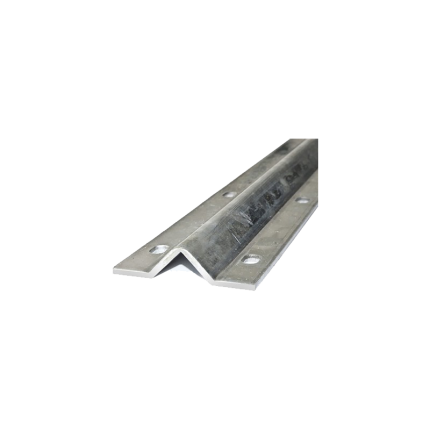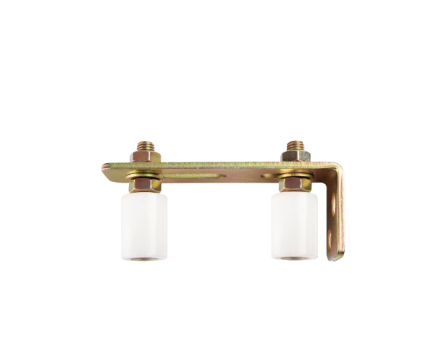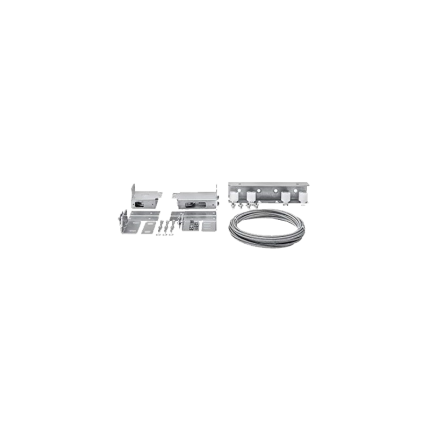Gate Hardware
Sliding Gate V-Track
Ship or pick up from our office.
Sliding Gate V-Track
NOTE: For 25 ft sliding gate V-Track, please do not make an online order.Because of the limit of the shipping length and weight, we have to cut the full length of the product (25') to 2 x (12'-6") for pick-up from our store OR 4 x (6'-3") to send by Canada Post.
If your order requires cutting services, additional costs will apply.
To create an order for sliding gate V-Track, please send your request with the shipping address, postal code, and the length of your inquiry in the note. You will receive a quotation with the shipping costs within a maximum of one business day. A sliding gate V-track is a specific type of ground track that a sliding gate rolls on, utilizing wheels with a complementary V-shaped groove. This system is one of the most common ways to implement a sliding driveway gate, especially for residential and light commercial applications. Here's a breakdown: Purpose: The sliding gate V-track as the linear guide and support for the entire sliding gate. It ensures that the gate moves in a straight line, smoothly, and without wobbling or derailing as it opens and closes. It's an integral part of a "rolling gate" system, where the gate literally rolls on the ground. Key Characteristics and Components:- V-Shape Profile: The most defining feature. The track has an inverted V-shape or a 90-degree angle (like an angle iron) with a slightly rounded top. This V-shape mates perfectly with the V-groove wheels attached to the bottom of the gate.
- Materials:
- Galvanized Steel (Most Common): Highly durable, strong, and resistant to corrosion due to the galvanization process. It can handle heavy gates and high traffic volumes. Sections are typically joined together to form the required length.
- Aluminum: Lighter weight and excellent corrosion resistance. Often used for lighter gates or in environments where rust is a major concern (like coastal areas).
- Installation:
- Bolt-Down: The V-track is typically designed to be bolted securely to a concrete driveway or foundation. It has pre-drilled holes for anchor bolts. This allows for easier installation on existing concrete and simpler replacement if a section gets damaged.
- Embeddable (Less Common for DIY): Some V-tracks are designed to be embedded directly into wet concrete during construction.
- Level and Straight: Crucially, the V-track must be installed perfectly level and straight along the entire travel path of the gate to ensure smooth and consistent operation. Any dips, humps, or curves will cause issues with the gate's movement and can put undue strain on the gate operator and wheels.
- Lengths: Sliding gate V-tracks are sold in sections (e.g., 6 feet, 10 feet, 2.4 meters, 3 meters). Multiple sections are joined together using connection pins or by welding to achieve the total required length, which should be at least twice the width of the gate opening to allow the gate to fully retract.
- Complementary Hardware:
- V-Groove Wheels: These are essential and roll directly on top of the V-track. As discussed previously, they have a V-shaped groove that fits snugly into the track.
- Guide Rollers/Posts: Used at the top of the gate to keep it upright and prevent tipping.
- Gate Stops: Installed at the ends of the track to prevent the gate from over-traveling.
- Stability: The sliding gate V-track V-groove design provides excellent lateral stability, keeping the gate aligned and preventing it from wobbling.
- Load Capacity: Due to the direct ground support and robust V-track/wheel combination, these systems can handle very heavy and long gates.
- Simple Mechanical Principle: The system is straightforward, making it reliable.
- Debris Accumulation: The main drawback is that the V-track, being on the ground, is susceptible to collecting dirt, leaves, gravel, snow, and ice. This debris can obstruct the gate's movement, cause wear on the wheels, and may even lead to derailment or damage to the gate opener. Regular cleaning of the track is essential, especially during winter months in Canada.
- Driveway Disruption: Installing a sliding gate V-track requires modifying the driveway surface, often by bolting it down or embedding it in concrete, which creates a slight raised profile.
- Water Drainage: Proper drainage around the track is important to prevent water pooling.
Support Roller
Ship or pick up from our office.
Support Roller
*Steel adjustable L-bracket included *6-1/4” Length x 2-5/8” Width (Heavy-duty bolts, nuts, 2 x rollers, and washers are included)Support Roller for sliding gates are essential components that ensure smooth, stable, and reliable gate operation.
They guide the gate along its track, preventing it from tipping or falling off and ensuring it opens and closes with minimal friction and noise.
Function:
-
Guidance:Support rollers are typically mounted on the gate posts and guide the gate along its track as it opens and closes.
-
Stability:They keep the gate upright and prevent it from swaying or falling out of alignment, especially in windy conditions or with heavier gates.
-
Smooth Operation:By minimizing friction, they allow the gate to slide easily and quietly, enhancing the user experience.
-
Durability:They are designed to withstand the wear and tear of regular use and exposure to the elements.
Types:
- Nylon Rollers: Often used due to their durability, smooth operation, and resistance to corrosion.
- Rubber Rollers: While cheaper, they may leave marks on the gate and wear out faster.
- V-Groove Wheels: Suitable for specific track types and known for their longevity.
Installation:
- Positioning: Support rollers are typically installed on the gate posts, positioned to guide the gate along its track.
- Spacing: A gap of 5-10mm is usually recommended between rollers to allow for some movement and prevent them from doing all the work, especially if the gate is not perfectly balanced.
- Fixation: They are usually secured with bolts or by welding them to the post.
Maintenance:
-
Lubrication:Applying a silicone-based lubricant to the support rollers and other moving parts can help maintain smooth operation and reduce noise.
-
Regular Inspection:Inspecting rollers for wear and tear or damage is recommended to ensure continued reliable performance.
Telescopic sliding gate hardware
Ship or pick up from our office.
Telescopic sliding gate hardware
Telescopic sliding gate hardware refers to the specialized components and kits used to construct and operate a telescopic sliding gate system. Unlike a traditional single-leaf sliding gate, a telescopic gate consists of multiple gate leaves (typically two or three) that slide and overlap each other as they open, significantly reducing the amount of "run-off" space required for the gate to retract. This makes them ideal for properties with limited lateral space. Here's a breakdown of the key hardware components and how they work: How a Telescopic Sliding Gate Works: The core principle behind a telescopic gate is the synchronized movement of its multiple leaves. This is typically achieved through a cable and pulley system or a geared track system.- Cable and Pulley System: This is a common method. When the primary gate leaf (the one directly driven by a motor or moved manually) begins to open, a series of cables and pulleys pull the secondary and tertiary leaves along parallel tracks. The cables are strategically routed so that each subsequent leaf moves at a faster rate, allowing them to stack neatly behind the primary leaf when fully open.
- Geared Track System: Some advanced systems use a geared track where a pinion on one gate leaf engages with a rack on the next, driving it along.
- Gate Leaves: These are the individual sections of the gate. They are designed to slide smoothly past each other.
- Tracks:
- Ground Tracks: Parallel tracks are installed on the ground for each gate leaf to slide on.
- Upper Guide Profile/Track: A top guide system is crucial for stability and smooth movement, preventing the gate leaves from wobbling or derailing.
- Wheels: Each gate leaf has wheels (often V-groove or round groove) that run along the ground tracks. These are typically heavy-duty to support the weight of the gate.
- Pulley System/Transmission Unit: This is the heart of the telescopic mechanism. It includes:
- Pulleys: Used to route and guide the steel cables.
- Steel Cables: Connect the gate leaves, ensuring synchronized movement.
- Cable Covers/Casings: Protect the cables and provide a neat appearance.
- Adjustable Pulley Systems/Tensioners: Allow for precise adjustment of cable tension to ensure smooth operation and prevent stretching over time.
- Connection Brackets/Couplers: Connect the cables to the gate leaves.
- Guide Brackets/Rollers: These are installed at the top of the gate or on a support post to keep the gate leaves aligned and stable as they move. They often feature nylon rollers to reduce friction and noise.
- Gate Stops and Receivers: To define the fully open and closed positions and secure the gate when closed.
- Gear Rack (for automated gates): If the gate is automated, a gear rack will be installed on the primary gate leaf, which engages with a pinion on the gate motor.
- Gate Motor (for automated systems): A powerful sliding gate motor is required, often a low-voltage DC motor with advanced electronics to handle the varying speeds and loads of the multiple leaves. A speed reduction gearbox may also be incorporated for safety.
- Space-Saving: The primary advantage, as they require significantly less run-off space than single-leaf sliding gates.
- Wider Opening: Allows for a wider clear opening in situations where space limitations would otherwise restrict it.
- Faster Operation: Can often open and close more quickly than a single, very large sliding gate.
- Aesthetics: Can be a more visually appealing solution for properties with limited space.
- Complexity: More complex to design and install than a standard sliding gate due to the synchronized movement.
- Maintenance: Requires regular lubrication and checking of the cable and pulley system to ensure smooth and reliable operation.
- Weight Distribution: Proper engineering is crucial to distribute the weight of multiple gate leaves evenly and ensure stability.












